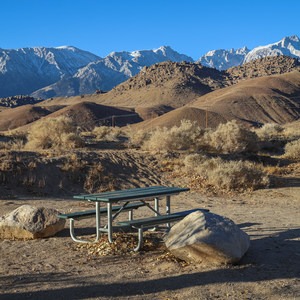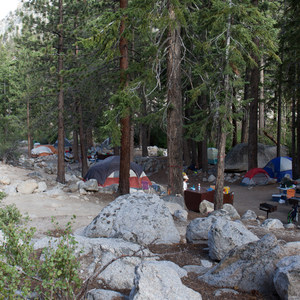You are here
A growing period of distrust of Japan followed the bombing of Pearl Harbor, and the U.S. Army turned the abandoned townsite of Manzanar at the base of the Eastern Sierra into one of several internment camps built throughout the Western states. At its peak, over 120,000 Japanese Americans and Japanese immigrants would be forcefully confined in camps like this; Manzanar would hold over 10,000. The camp held internees from 1942 until 1945. The museum is a monument to this era of U.S. history.
Manzanar was chosen by the National Parks as being the best-preserved of the former camps. Today, an indoor museum contains recreations of the barracks that held the internees, along with numerous displays relating to all facets of the detention sites' construction, operation, and living conditions and routines. The site also hosts programs by authors and others educated on life at Manzanar, and has changing art exhibits inside.
A film about the camp's history runs every half-hour in the museum theater, and it presents a compelling and emotional picture of those whose lives were affected by the anti-Japanese sentiment and the internment camps. The process of Japanese internment was carried out dishonestly. "We were told we were being evacuated so the government could protect us," reported an internee. "When we arrived I saw armaments, not facing out, facing in."
Barbed wire fences surrounded the camps, and armed guards watched from guard towers. Manzanar was spread over an area of about 540 acres, with many internees taken from their homes in the Los Angeles area.
Manzanar is continually undergoing improvements to its museum features, with more displays being added and more of the grounds groomed for visitors. Currently it is possible to drive a ring road that circles a large portion of the former camp's interior. Visitors can also walk through most of the grounds. Admission to the grounds and museum is free. The site is operated by the National Park Service. Additional information can be found at the Manzanar National Histroic Site (NPS). The site is one of many interesting stops to make when passing along Highway 395, including the Cottonwood Creek Charcoal Kilns, the Olancha Dunes, the Olancha Sculpture Garden, and the Eastern California Museum Trail, which also has a sizeable collection of artifacts from Manzanar.











Comments
Sign In and share them.